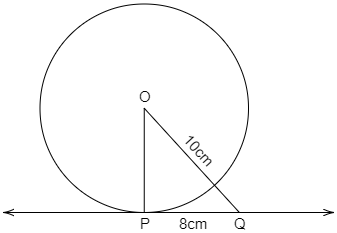
In the figure, PQ is tangent to the circle at P. Find the radius, if $PQ = 8cm$ and $OR = 10cm$.


Answer
552.9k+ views
Hint: To solve this question, we must have some basic knowledge of geometry, its identities, and also Pythagoras’s theorem. First of all, we will study the diagram of the above question which will make the solution of the question easier. From the diagram, we will see that the points O, P, and Q form a right-angled triangle, so we can simply find the length OP by applying Pythagoras’s theorem. This will be our final answer.
Step-By-Step answer:
First of all, we will see the diagram of the question which is given below,
Let us assume that the length OP is $x$.
As we can see in the above figure,
$ \Rightarrow OQ = 10cm,PQ = 8cm$
As we know, that the angle between the tangent and radius of a circle is the right angle.
$ \Rightarrow \angle OPQ = 90^\circ $
Now, we can see that the triangle has met all the requirements for applying Pythagoras’s theorem to it.
The formula of Pythagoras theorem is,
${h^2} = {p^2} + {b^2}$
Where $p = $ perpendicular
$b = $ base
$h = $ hypotenuse
So, applying Pythagoras’s theorem to the triangle as stated above, we can see that,
$ \Rightarrow {10^2} = {x^2} + {8^2}$
Square the terms,
$ \Rightarrow 100 = {x^2} + 64$
Move constant part on one side,
$ \Rightarrow {x^2} = 100 - 64$
Subtract the values,
$ \Rightarrow {x^2} = 36$
Taking square root on both sides,
$\therefore x = 6cm$
Hence, the radius is 6cm.
Note: To solve this question, don’t forget to make the diagram before solving as this will make solving the question easier. Also, for Pythagoras’s theorem, substitute the values of perpendicular, base, and hypotenuse carefully at the right place. Also, never become nervous if you don’t see a perfect square number inside the square root.
Step-By-Step answer:
First of all, we will see the diagram of the question which is given below,
Let us assume that the length OP is $x$.
As we can see in the above figure,
$ \Rightarrow OQ = 10cm,PQ = 8cm$
As we know, that the angle between the tangent and radius of a circle is the right angle.
$ \Rightarrow \angle OPQ = 90^\circ $
Now, we can see that the triangle has met all the requirements for applying Pythagoras’s theorem to it.
The formula of Pythagoras theorem is,
${h^2} = {p^2} + {b^2}$
Where $p = $ perpendicular
$b = $ base
$h = $ hypotenuse
So, applying Pythagoras’s theorem to the triangle as stated above, we can see that,
$ \Rightarrow {10^2} = {x^2} + {8^2}$
Square the terms,
$ \Rightarrow 100 = {x^2} + 64$
Move constant part on one side,
$ \Rightarrow {x^2} = 100 - 64$
Subtract the values,
$ \Rightarrow {x^2} = 36$
Taking square root on both sides,
$\therefore x = 6cm$
Hence, the radius is 6cm.
Note: To solve this question, don’t forget to make the diagram before solving as this will make solving the question easier. Also, for Pythagoras’s theorem, substitute the values of perpendicular, base, and hypotenuse carefully at the right place. Also, never become nervous if you don’t see a perfect square number inside the square root.
Recently Updated Pages
Master Class 9 Social Science: Engaging Questions & Answers for Success

Master Class 9 Science: Engaging Questions & Answers for Success

Master Class 9 English: Engaging Questions & Answers for Success

Master Class 9 Maths: Engaging Questions & Answers for Success

Master Class 9 General Knowledge: Engaging Questions & Answers for Success

Class 9 Question and Answer - Your Ultimate Solutions Guide

Trending doubts
Which places in India experience sunrise first and class 9 social science CBSE

Fill the blanks with the suitable prepositions 1 The class 9 english CBSE

Write the 6 fundamental rights of India and explain in detail

Difference Between Plant Cell and Animal Cell

What is pollution? How many types of pollution? Define it

What is the Full Form of ISI and RAW





